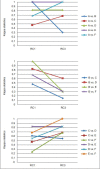Inter-reader variability in follicular lymphoma grading: Conventional and digital reading
- PMID: 24392244
- PMCID: PMC3869955
- DOI: 10.4103/2153-3539.120747
Inter-reader variability in follicular lymphoma grading: Conventional and digital reading
Abstract
Context: Pathologists grade follicular lymphoma (FL) cases by selecting 10, random high power fields (HPFs), counting the number of centroblasts (CBs) in these HPFs under the microscope and then calculating the average CB count for the whole slide. Previous studies have demonstrated that there is high inter-reader variability among pathologists using this methodology in grading.
Aims: The objective of this study was to explore if newly available digital reading technologies can reduce inter-reader variability.
Settings and design: IN THIS STUDY, WE CONSIDERED THREE DIFFERENT READING CONDITIONS (RCS) IN GRADING FL: (1) Conventional (glass-slide based) to establish the baseline, (2) digital whole slide viewing, (3) digital whole slide viewing with selected HPFs. Six board-certified pathologists from five different institutions read 17 FL slides in these three different RCs.
Results: Although there was relative poor consensus in conventional reading, with lack of consensus in 41.2% of cases, which was similar to previously reported studies; we found that digital reading with pre-selected fields improved the inter-reader agreement, with only 5.9% lacking consensus among pathologists.
Conclusions: Digital whole slide RC resulted in the worst concordance among pathologists while digital whole slide reading selected HPFs improved the concordance. Further studies are underway to determine if this performance can be sustained with a larger dataset and our automated HPF and CB detection algorithms can be employed to further improve the concordance.
Keywords: Centroblast; follicular lymphoma; inter-reader variability; whole-slide images.
Figures






Similar articles
-
Classification of follicular lymphoma: the effect of computer aid on pathologists grading.BMC Med Inform Decis Mak. 2015 Dec 30;15:115. doi: 10.1186/s12911-015-0235-6. BMC Med Inform Decis Mak. 2015. PMID: 26715518 Free PMC article.
-
Mitosis detection in breast cancer histological images An ICPR 2012 contest.J Pathol Inform. 2013 May 30;4:8. doi: 10.4103/2153-3539.112693. Print 2013. J Pathol Inform. 2013. PMID: 23858383 Free PMC article.
-
Mouse cursor movement and eye tracking data as an indicator of pathologists' attention when viewing digital whole slide images.J Pathol Inform. 2012;3:43. doi: 10.4103/2153-3539.104905. Epub 2012 Dec 20. J Pathol Inform. 2012. PMID: 23372984 Free PMC article.
-
Whole Slide Imaging: Technology and Applications.Adv Anat Pathol. 2020 Jul;27(4):251-259. doi: 10.1097/PAP.0000000000000273. Adv Anat Pathol. 2020. PMID: 32452840 Review.
-
Whole slide imaging: uses and limitations for surgical pathology and teaching.Biotech Histochem. 2015 Jul;90(5):321-30. doi: 10.3109/10520295.2015.1033463. Epub 2015 Apr 22. Biotech Histochem. 2015. PMID: 25901738 Review.
Cited by
-
Spatial mapping of the DNA adducts in cancer.DNA Repair (Amst). 2023 Aug;128:103529. doi: 10.1016/j.dnarep.2023.103529. Epub 2023 Jun 27. DNA Repair (Amst). 2023. PMID: 37390674 Free PMC article. Review.
-
Classification of follicular lymphoma: the effect of computer aid on pathologists grading.BMC Med Inform Decis Mak. 2015 Dec 30;15:115. doi: 10.1186/s12911-015-0235-6. BMC Med Inform Decis Mak. 2015. PMID: 26715518 Free PMC article.
-
Assessment of pathological response to therapy using lipid mass spectrometry imaging.Sci Rep. 2016 Nov 14;6:36814. doi: 10.1038/srep36814. Sci Rep. 2016. PMID: 27841360 Free PMC article.
-
Ensemble deep learning enhanced with self-attention for predicting immunotherapeutic responses to cancers.Front Immunol. 2022 Dec 1;13:1025330. doi: 10.3389/fimmu.2022.1025330. eCollection 2022. Front Immunol. 2022. PMID: 36532083 Free PMC article.
-
The impact of histological grade on outcomes in follicular lymphoma: An analysis of patients in the SEER database in the context of evolving disease classification and treatment.Br J Haematol. 2022 Dec;199(5):696-706. doi: 10.1111/bjh.18404. Epub 2022 Aug 16. Br J Haematol. 2022. PMID: 35973829 Free PMC article.
References
-
- Anderson JR, Armitage JO, Weisenburger DD. Epidemiology of the non-Hodgkin's lymphomas: Distributions of the major subtypes differ by geographic locations. Non-Hodgkin's Lymphoma Classification Project. Ann Oncol. 1998;9:717–20. - PubMed
-
- López-Guillermo A, Caballero D, Canales M, Provencio M, Rueda A, Salar A, et al. Clinical practice guidelines for first-line/after-relapse treatment of patients with follicular lymphoma. Leuk Lymphoma. 2011;52(Suppl 3):1–14. - PubMed
-
- Ardeshna KM, Smith P, Norton A, Hancock BW, Hoskin PJ, MacLennan KA, et al. Long-term effect of a watch and wait policy versus immediate systemic treatment for asymptomatic advanced-stage non-Hodgkin lymphoma: A randomised controlled trial. Lancet. 2003;362:516–22. - PubMed
-
- Horning SJ, Rosenberg SA. The natural history of initially untreated low-grade non-Hodgkin's lymphomas. N Engl J Med. 1984;311:1471–5. - PubMed
-
- Brice P, Bastion Y, Lepage E, Brousse N, Haïoun C, Moreau P, et al. Comparison in low-tumor-burden follicular lymphomas between an initial no-treatment policy, prednimustine, or interferon alfa: A randomized study from the Groupe d’Etude des Lymphomes Folliculaires. Groupe d’Etude des Lymphomes de l’Adulte. J Clin Oncol. 1997;15:1110–7. - PubMed
Grants and funding
LinkOut - more resources
Full Text Sources
Other Literature Sources

